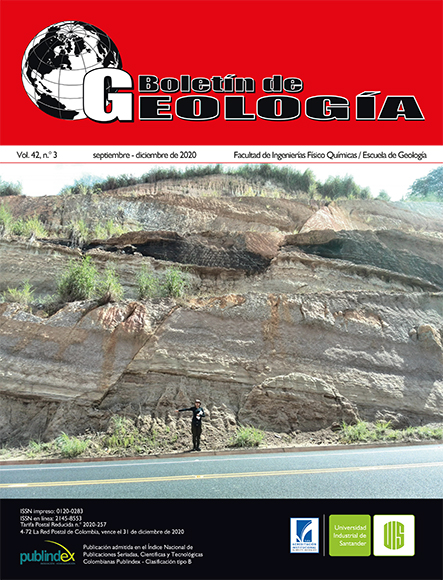Publicado 2020-10-05
Palabras clave
- Caracterización,
- Petrofísica,
- Yacimientos,
- Modelos 1D,
- Facies
- Redes neuronales ...Más
Cómo citar
Derechos de autor 2020 Boletín de Geología

Esta obra está bajo una licencia internacional Creative Commons Atribución 4.0.
Altmetrics
Resumen
La caracterización petrofísica de yacimientos desempeña un rol importante en la industria petrolera, siendo primordial en el gerenciamiento integral y la optimización de procesos de recuperación. El siguiente trabajo planteó el modelado petrofísico y de facies para las unidades formacionales del Grupo Grant y el yacimiento Anderson dentro del Bloque-Bunda-3D-2009 de la cuenca Canning en Australia. Esta propuesta fue dividida en dos etapas. La etapa conceptual se basó en el estudio de la migración y acumulación de hidrocarburos en el área, y la creación de un inventario desde la información registrada en el Sistema de Gestión de Información Geotérmica y de Petróleo de Australia Occidental (WAPIMS). La segunda etapa se desarrolló considerando que la cantidad y distribución de lutitas presentes en las areniscas, tienen un gran impacto en la productividad de los yacimientos de hidrocarburos. Así, el primer paso fue calcular el volumen de lutitas a través del índice lineal de rayos gamma. Posteriormente, se modelaron las facies mediante el uso de redes neuronales y los resultados fueron comparados con las descripciones litológicas reportadas de los núcleos de diámetro completo de perforación. La porosidad efectiva fue modelada mediante el registro de densidad volumétrica de la roca y el tipo de distribución de arcilla; la saturación de agua mediante la correlación de Poupon-Leveaux y el modelo de permeabilidad horizontal fue generado con los datos de análisis convencionales de núcleos de diámetro completo de perforación. Se resalta que la presencia de pirita afectó la respuesta de los registros de densidad volumétrica, porosidad neutrón y de resistividad para algunos pozos del área. Igualmente, el hidrodinamismo actuante y la presencia de agua meteórica en los acuíferos incidió en la respuesta del registro eléctrico resistivo, resultando complejo la identificación de contactos agua - hidrocarburo.
Descargas
Referencias
Archie, G. (1942). The electrical resistivity log as an aid in determining some reservoir characteristics. Transactions of the AIME, 146(01), 54-62. https://doi.org/10.2118/942054-G
Arps, J. (1953). The effect of temperature on the density and electrical resistivity of sodium chloride solutions. Journal of Petroleum Technology, 5(10), 17-20. https://doi.org/10.2118/953327-G
Asquith, B. (1998). Log Evaluation of Shaly Sandstones Reservoirs: A practical guide. Volume 31, AAPG.
Cadman, S.; Pain, L.; Vuckovic, V; le Poidevin, S. (1993). Canning Basin, W.A. Bureau of Resource Sciences, Australian Petroleum Accumulations Report 9.
Chopra, S.; Michelena, R. (2011). Introduction to this special section: Reservoir characterization. The Leading Edge, 30(1), 35-37. https://doi.org/10.1190/1.3535430
Crostella, A. (1998). A review of oil occurrences within the Lennard Shelf, Canning Basin, Western Australia. Western Australia Geological Survey, Report.
Crowe, R.; Towner, R. (1976a). Definitions of some new and revised rock units in the Canning Basin. Geological Survey of Western Australia. Record 1976/24, p 23.
Crowe, R.; Towner, R. (1976b). Permian stratigraphic nomenclature (Noonkanbah 1:250000). Geological Survey of Western Australia. Annual Report – 1975, p. 56-58.
Crowe, R.; Towner, R. (1976c). Environmental interpretation of the Permian Nura Mermeber of the Poole Sandstone, Noonkanbah sheet area, Canning Basin: a gradation between fluviatile and shallow water marine facies. Western Australia Department of Mines. Annual Report 1975, p. 59-62.
Forman, D.; Wales, D. (1981). Geological evolution of the Canning Basin, Western Australia. Commonwealth of Australia.
Horsfall, O.; Davies, D.; Davies, O. (2015). Hydrocarbon reservoir characterization using well log in Niger Delta Basin of Nigeria. International Journal of Applied and Natural Sciences, 4(5), 55-64.
Hubbert, M. (1953). Entrapment of petroleum under hydrodynamic conditions. AAPG Bulletin, 37(8), 1954-2026. https://doi.org/10.1306/5CEADD61-16BB-11D7-8645000102C1865D
Illidge, E. (2017). Inversión y atributos sísmicos en la clasificación de Facies. Tesis de Maestría, Universidad Industrial de Santander, Bucaramanga, Colombia.
Kamel, M.; Mabrouk, W. (2003). Estimation of shale volume using a combination of three porosity logs. Journal of Petroleum Science and Engineering, 40(3-4), 145-157. https://doi.org/10.1016/S0920-4105(03)00120-7
Kennard, J.; Jackson, M.; Romine, R.; Southgate, P. (1994a). Canning Basin project Stage - II – Geohistory Modelling. Australian Geology Survey Organization.
Kennard, J.; Jackson, M.; Romine, K.; Shaw, E.; Southgate, P. (1994b). Depositional sequences and associated petroleum systems of the Canning Basin, W.A. Western Australian Basin Symposium, Perth, Australia.
Klimentos, T. (1995). Pyrite volume estimation by well log analysis and petrophysical studies. The Log Analyst, 36(6), 11-17.
Kumar, M.; Dasgupta, R.; Singha, D.; Singh, N. (2018). Petrophysical evaluation of well log data and rock physics modeling for characterization of Eocene reservoir in Chandmari oil field of Assam-Arakan basin, India. Journal of Petroleum Exploration and Production Technology, 8(2), 323-340. https://doi.org/10.1007/s13202-017-0373-8
Martinez, D.; Winkler, F.; Granados, L. (1983). The Carboniferous of the World. Volume 2 publication Issue 20. International Union of Geological Sciences Publication. Instituto Geológico y Minero de España.
McWhale, J.; Playford, P.; Lindner, A.; Gleinster, B.; Balme, B. (1958). The stratigraphy of western Australia. Journal of the Geological Society of Australia, 4(2), 1-153.
https://doi.org/10.1080/00167615608728471
Mory, A. (2010). A review of mid-Carboniferous to Triassic stratigraphy, Canning Basin, Western Australia. Geological Survey of Western Australia. Report 107.
Poupon, A.; Leveaux, J. (1971). Evaluation of water saturation in Shaly Formations. SPWLA 12th Annual Logging Symposium. Dallas, USA.
Rojas, D.; Cabrera, M. (2019). Caracterización petrofísica de yacimientos implementando atributos e inversión sísmica. Tesis, Universidad Industrial de Santander, Bucaramanga, Colombia.
Rudge, T. (2010). Bunda 3D 2009 Seismic Survey Interpretation Report L6, L8 and EP104 R5. Submitted to the Department of Mines and Petroleum, West-Australia. Buru Energy.
Thomas, E.; Stieber, S. (1975). The Distribution of Shale in Sandstones and its effct upon porosity. SPWLA 16th Annual Logging Symposium, New Orleans, USA.

